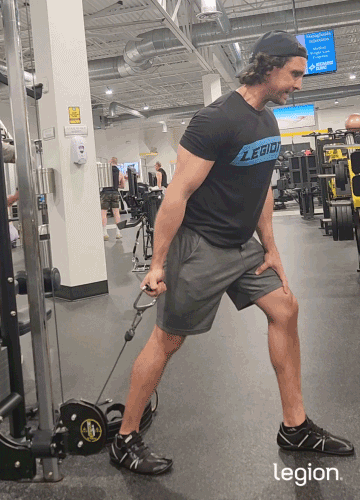The Bayesian cable curl is unlike any other biceps exercise.
For starters, the form is unique: you curl a cable one arm at a time with your arm behind your body and your back to the cable stack (hence why people often refer to it as “the face-away cable curl” or “behind-the-back cable curl”).
It also trains your biceps while fully stretched and applies tension to your muscles throughout the entire range of motion—something you don’t get with free-weight alternatives. Crucially, these facets make it particularly effective for building biceps mass.
So, if you want to understand how to perform the Bayesian curl, why it’s so effective, and how to avoid mistakes people often make while performing the exercise, this article is for you.
How to Do the Bayesian Cable Curl
To master Bayesian cable curls, split the exercise into three parts: set up, curl, and descend.
1. Set up
Set the pulley on a cable machine to the lowest setting and attach a single-handle attachment. Position your feet next to the pulley, grab the handle in your right hand, and then turn your back to the cable stack.
Step 1-to-2 feet forward with your left foot, place your left hand on your left thigh for stability, and lean slightly forward.
Rotate your right wrist so your palm faces forward, position your right elbow about an inch behind your right lat, and let the cable pull your right arm straight so you feel your right biceps stretch.
2. Curl
Without moving your right elbow forward, bend your right elbow to curl the handle toward your right shoulder.
3. Descend
Reverse the movement and return to the starting position.
Here’s how proper Bayesian cable curl form should look when you put it all together:



Bayesian Cable Curl Benefits
They’re ideal for building biceps mass.
For an exercise to be effective, it must place a lot of tension on the muscle you’re trying to train. It also helps if it trains the muscle when fully stretched.
The problem with most biceps exercises is that they fall short in these areas.
Exercises like dumbbell and barbell curls place little tension on the biceps at the bottom and top of each rep. And since your elbows stay at your sides during both exercises, they don’t train the biceps when stretched. The biceps are only fully lengthened when your elbows are behind your body.
The Bayesian curl fixes these issues. By performing the exercise with a cable and turning away from the cable stack, you maintain tension on your biceps throughout the entire range of motion. Keeping your elbow slightly behind your torso as you perform the exercise also ensures the biceps fully stretch.
These factors make the Bayesian curl ideal for building biceps mass.
It trains your biceps unilaterally.
The “face-away curl” is a unilateral exercise, which means it allows you to train one side of your body at a time.
This is beneficial because unilateral exercises . . .
- May enable you to lift more total weight than you can with some bilateral exercises, which may help you gain more muscle over time
- Help you develop a greater mind-muscle connection with your biceps because you only need to focus on one side of your body at a time
- Help you correct muscle imbalances, because both sides of your body are forced to lift the same amount of weight (one side can’t “take over” from the other)
It maximizes biceps growth.
Your biceps are heavily involved in “pulling” exercises, such as the lat pulldown, row, and pull-up.
However, research shows that if you want to maximize biceps development, doing compound pulling exercises isn’t enough—you have to do biceps isolation exercises, too.
There are two reasons for this:
- Biceps isolation exercises like the Bayesian cable curl allow you to train your biceps in different ways—at different angles and through different ranges of motion—which probably produces more balanced and complete growth than doing just 2 or 3 pulling exercises.
- Biceps isolation exercises allow you to train your biceps when it’s no longer practical to do so with a compound exercise. For instance, after several sets of pulling exercises, your lats, traps, and rhomboids will probably be bushed, but your biceps may be comparatively fresh. Adding a few sets of curls ensures they’re adequately stimulated, which is vital to maximize growth.
Bayesian Cable Curl: Muscles Worked
The main muscles worked by the Bayesian cable curl are the biceps brachii (or “biceps”), the two-headed muscles on the front of your upper arms, between your shoulders and elbows.
Here’s how the biceps look on your body:

Common Bayesian Cable Curl Mistakes
Letting the cable pull your arm too far backward.
If the weight pulls your arm so far backward that your elbow is several inches behind your torso, you lose tension on your biceps at the top and bottom of each rep, which reduces the exercise’s effectiveness. Fix this by keeping your elbow stationary and slightly behind your lat throughout each rep.
Lifting too much weight.
Trying to lift too much weight on the Bayesian curl makes the exercise difficult to perform correctly—the cable will pull you backward, you’ll have trouble training through a full range of motion, and you’re more likely to engage other muscle groups to “cheat” the weight up—all of which makes the exercise less effective.
Avoid this mistake by selecting a weight that allows you to perform the exercise with proper form, through a full range of motion, and without other muscles assisting your biceps.
Hitting your wrist with the cable.
If the cable hits your wrist as you curl the weight up, you’re not leaning far enough forward. Correct this by bending forward slightly further at the hips.
FAQ #1: What is the difference between the incline curl and Bayesian curl?
The main difference between the Bayesian cable curl and incline dumbbell curl is execution: in the Bayesian curl, you train each arm independently using a cable machine and while standing, whereas in the incline curl, you train both arms simultaneously using dumbbells and while seated.
However, both exercises work your biceps similarly and comparably, so you can use them interchangeably.
FAQ #2: What is the moment arm in a Bayesian curl?
In weightlifting, a moment arm is the distance between the joint and the line of force applied during an exercise. It determines how much leverage or torque you must produce to move the joint.
For example, when you perform a dumbbell curl, the moment arm is the distance from your elbow to the weight, which determines how much force your biceps need to exert to lift the dumbbell.
One of the main advantages of the Bayesian curl is that it maintains a consistent moment arm throughout the range of motion, which helps to keep constant tension on the biceps. This is unlike traditional dumbbell or barbell curls, where the moment arm reduces tension at the top and bottom of each rep.
FAQ #3: Do Bayesian curls work the long head?
Yes, Bayesian curls position your arm behind your body, which helps you emphasize the biceps long head more than exercises that position your elbows beside or in front of your torso.
Additionally, you supinate your wrists (turn your palms upward) during the Bayesian cable curl, which also helps you emphasize the long head.
+ Scientific References
- Schoenfeld, Brad J. “The Mechanisms of Muscle Hypertrophy and Their Application to Resistance Training.” Journal of Strength and Conditioning Research, vol. 24, no. 10, 2010, pp. 2857–72, https://doi.org/10.1519/JSC.0b013e3181e840f3.
- Oranchuk, Dustin J., et al. “Isometric Training and Long-Term Adaptations: Effects of Muscle Length, Intensity, and Intent: A Systematic Review.” Scandinavian Journal of Medicine & Science in Sports, vol. 29, no. 4, 13 Jan. 2019, pp. 484–503, https://doi.org/10.1111/sms.13375.
- Maeo, Sumiaki, et al. “Triceps Brachii Hypertrophy Is Substantially Greater after Elbow Extension Training Performed in the Overhead versus Neutral Arm Position.” European Journal of Sport Science, 12 July 2022, pp. 1–26, https://doi.org/10.1080/17461391.2022.2100279.
- Jakobi, Jennifer M., and Philip D. Chilibeck. “Bilateral and Unilateral Contractions: Possible Differences in Maximal Voluntary Force.” Canadian Journal of Applied Physiology, vol. 26, no. 1, Feb. 2001, pp. 12–33, https://doi.org/10.1139/h01-002.
- Janzen, Cora L., et al. “The Effect of Unilateral and Bilateral Strength Training on the Bilateral Deficit and Lean Tissue Mass in Post-Menopausal Women.” European Journal of Applied Physiology, vol. 97, no. 3, 28 Mar. 2006, pp. 253–260, https://doi.org/10.1007/s00421-006-0165-1.
- Costa, Bruna Daniella de Vasconcelos, et al. “Does Performing Different Resistance Exercises for the Same Muscle Group Induce Non-Homogeneous Hypertrophy?” International Journal of Sports Medicine, vol. 42, no. 09, 13 Jan. 2021, pp. 803–811, https://doi.org/10.1055/a-1308-3674.
- Landin, Dennis, et al. “Actions of the Biceps Brachii at the Shoulder: A Review.” Journal of Clinical Medicine Research, vol. 9, no. 8, 2017, pp. 667–670, https://doi.org/10.14740/jocmr2901w.
- Jarrett, Claudius D., et al. “Anatomic and Biomechanical Analysis of the Short and Long Head Components of the Distal Biceps Tendon.” Journal of Shoulder and Elbow Surgery, vol. 21, no. 7, July 2012, pp. 942–948, https://doi.org/10.1016/j.jse.2011.04.030.

